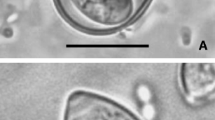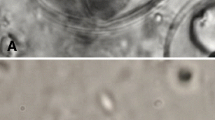Abstract
The SPF rabbits were inoculated with oocysts of Eimeria flavescens and the first newly developed oocysts were recovered. They were used for inoculation of other rabbits which conseqeuntly excreted oocysts sooner than in the previous passage. By repeated use of this method, the prepatent period was shortened after 18 passages by more than 60 h. The endogenous development of this precocious line (PL) differed from that of the original strain (OS). Compared to OS, two asexual generations, second (or third) and fourth, were absent in PL. The first merogony took place in the jejunum and ileum in OS and, in contrast, in the large intestine in PL. Like in other rabbit coccidia, two types of meronts (A and B) were seen in each generation. However, the ratio of B: A meronts in the last (fifth) asexual generation as well as ratio of microgamonts:macrogamonts differs in OS and PL.


Similar content being viewed by others
References
Coudert P, Licois D, Drouet-Viard F (1995) Eimeria species and strains of the rabbits. In: Eckert J, Braun R, Shirley MW, Coudert P (eds) Guidelines on techniques in coccidiosis research. European Commission, Directorate-General XII, Science, Research and Development Environment Research Programme, pp 66–71
Haberkorn A (1970) Die Entwicklung von Eimeria falciformis (Eimer 1870) in der weissen Maus (Mus musculus). Z Parasitenkd 34:49–67
Lee EH, Remmler O, Fernando MA (1977) Sexual differentiation in Eimeria tenella (Sporozoa: Coccidia). J Parasitol 63:155–156
Licois D, Coudert P, Boivin M, Drouet-Viard F, Provôt F (1990) Selection and characterization of a precocious line of Eimeria intestinalis, an intestinal rabbit coccidium. Parasitol Res 76:192–198
Licois D, Coudert P, Bahagia S, Rossi GL (1992) Characterisation of Eimeria species in rabbits (Oryctolagus cuniculus): endogenous development of Eimeria intestinalis Cheissin, 1948. J Parasitol 78:1041–1046
Licois D, Coudert P, Drouet-Viard F, Boivin M (1994) Eimeria media: Selection and characterization of a precocious line. Parasitol Res 80:48–52
Licois D, Coudert P, Drouet-Viard F, Boivin M (1995) Eimeria magna: Pathogenicity, immunogenicity and selection of a precocious line. Vet Parasitol 60:27–35
Pakandl M., Coudert P (1999) Life cycle of Eimeria vejdovskyi Pakandl, 1988: electron microscopy study. Parasitol Res 85:850–854
Pakandl M, Gaca K, Drouet-Viard F, Coudert P (1996b) Eimeria coecicola: Endogenous development in gut-associated lymphoid tissue. Parasitol Res 82:347–351
Pakandl M, Gaca K, Licois D, Coudert P (1996c) Eimeria media Kessel 1929: Comparative study of the endogenous development between precocious and parental strains. Vet Res 27:465–472
Pakandl M, Eid Ahmed N, Licois D, Coudert P (1996a) Eimeria magna Pérard, 1925: Study of the endogenous development of parental and precocious strains. Vet Parasitol 65:213–222
Pakandl M, Černík F, Coudert P (2003) The rabbit coccidium Eimeria flavescens Marotel and Guilhon, 1941: an electron microscopic study of its life cycle. Parasitol Res 91:304–311
Shirley MW, Harvey DA (1996) Eimeria tenella: infection with a single sporocyst gives a clonal population. Parasitology 112:523–528
Streun A, Coudert P, Rossi GL (1979) Characterization of Eimeria species. II. Sequential morphologic study of the endogenous cycle of Eimeria perforans (Leuckart, 1879; Sluiter and Swellengrebel, 1912) in experimentally infected rabbits. Z Parasitenkd 60:37–53
Acknowledgements
The present work was supported by the Grant Agency of the Academy of Sciences of the Czech Republic, Project No. S6022002, Research project of the Institute of Parasitology, AS CR (Z60220518) and by BIOPHARM, Research Institute of Biopharmacy and Veterinary Drugs, Jílové near Prague, Czech Republic in frame of COST project 0C848.02. We thank František Černík and Zbyněk Houdek from BIOPHARM for help in performing the experiments and Marie Kreimová from Institute of Parasitology for technical assistance. The experiments performed on the animals complied with the current laws of the Czech Republic.
Author information
Authors and Affiliations
Corresponding author
Rights and permissions
About this article
Cite this article
Pakandl, M. Selection of a precocious line of the rabbit coccidium Eimeria flavescens Marotel and Guilhon (1941) and characterisation of its endogenous cycle. Parasitol Res 97, 150–155 (2005). https://doi.org/10.1007/s00436-005-1411-x
Received:
Accepted:
Published:
Issue Date:
DOI: https://doi.org/10.1007/s00436-005-1411-x




